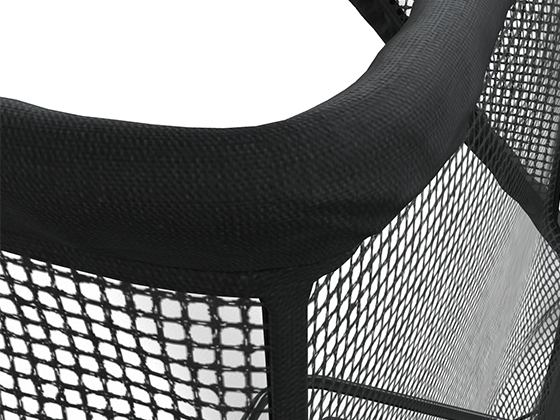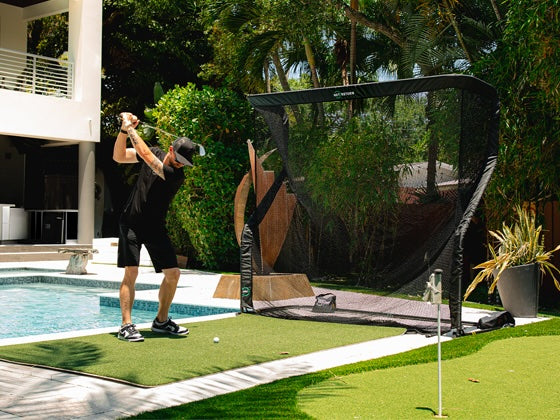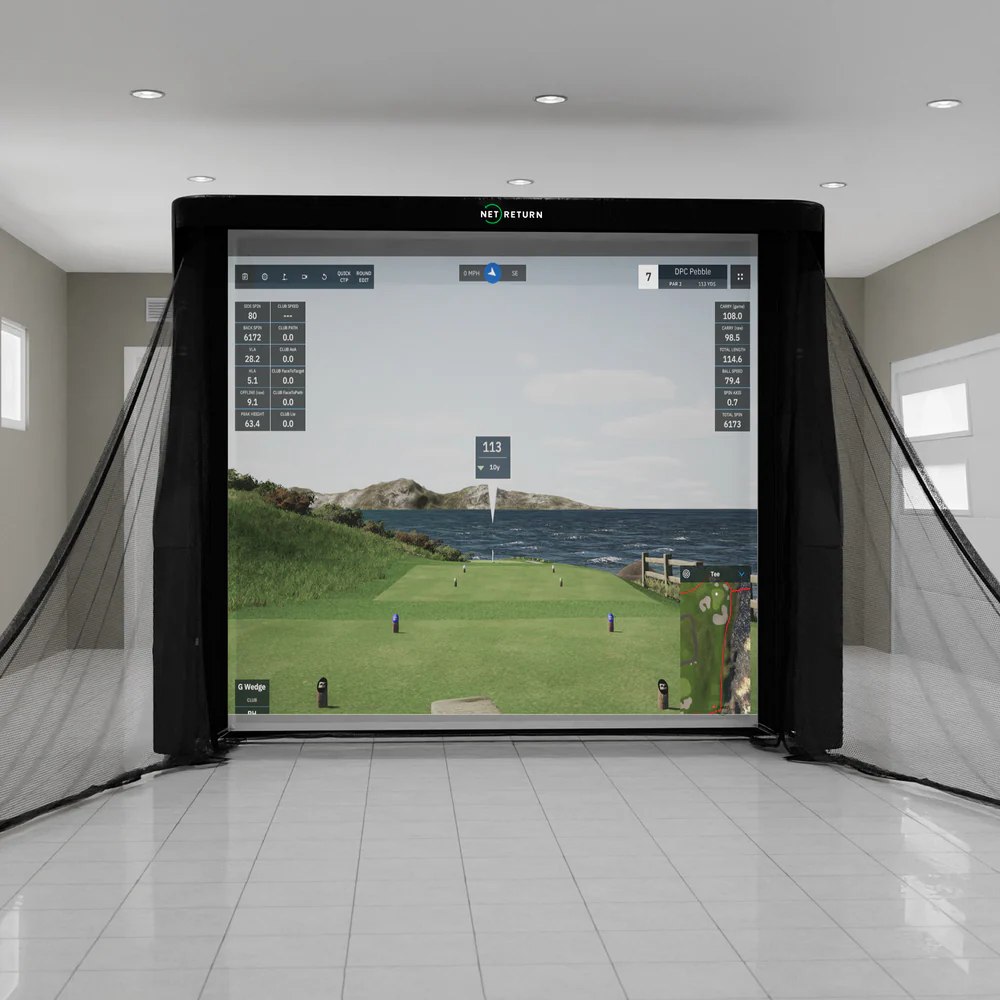Advancing your game through consistent, data-driven practice is what we do best at The Net Return. With our premium Simulator Series and practice nets trusted by pros, we’ve seen firsthand how technology can bridge the gap between the driving range and real-world performance. Let’s discuss how golf simulators work, what they cost, what space you need, the accuracy you can expect, and how putting fits into the equation — all from our perspective as a leading provider of premium home training solutions.
How Do Golf Simulators Work?
At the heart of every golf simulator is a launch monitor — a device using radar, camera-based sensors, or infrared systems to track your club and ball data. Popular launch monitors, FlightScope Mevo+, ForeSight GC3, Uneekor Eye Mini, FullSwing KIT, capture metrics such as:
- Ball speed, spin rate, and launch angle
- Club path and face angle
- Carry distance and total distance
These data points are fed into simulation software, rendering your shot trajectory on a virtual course or driving range. Advanced systems even simulate roll, wind, elevations, and course terrain for truly immersive realism. When paired with our Simulator Bay 12, which features a floating HD impact screen and high-impact netting, you get a premium indoor setup that replicates on-course conditions beautifully.
How Much Is a Golf Simulator?
The cost of a golf simulator varies depending on several components:
- Simulator enclosure: Our Simulator Series Bays range from around $1,995 for the Sim Bay 8 up to $2,995 for the Sim 12.
- Launch monitor: Mevo+ is an entry level systems that starts at $1,839. Premium systems (Uneekor, Foresight GC3, etc.) range from $3,000 to $7,000+.
- Projector and screen: A short-throw projector typically runs $1,000–$2,000, plus a simulation screen or valence kit ($189–$299).
- Mat, turf, accessories: Expect to invest $500–$2,000 depending on quality.
A complete simulator setup — enclosure, launch monitor, projector, turf, software — typically starts around $6,000 and can exceed $12,000 for high-end systems.
How Accurate Is a Golf Simulator?
Launch Data vs. Actual Conditions
Launch monitor technology has matured significantly. Units like the SkyTrak+ and GC3 claim accuracy within ±1–2 mph for ball speed, ±50 rpm for spin, and ±1° for launch angle, often validated by third-party testers.
Translation to On-Course Performance
High-end systems offer excellent consistency. Expect about 95–98% realistic accuracy in simulated carry and total distance. Some minor discrepancies remain due to:
- Variations in turf roll behavior
- Environmental factors (wind, humidity)
- Surface feel compared to real fairways
Still, the data is reliable for practice, skill-building, and club fitting, especially when using premium simulators paired with quality enclosures like ours.
Role of the Enclosure
Our Simulator Series features super-white floating screens that absorb ball energy, minimizing unexpected bounces — crucial for clean impact and uninterrupted data capture. The high-impact netting ensures consistency in tracking regardless of shot speed.
How Much Space Do You Need?
Ceiling Height
All Simulator Series Bays require a ceiling height of at least 9 feet. For players over 6'2", however, 10 feet is ideal to accommodate full swings with drivers.
Horizontal Footprint
Choose your bay size based on room dimensions:
- Sim 8: 8'W × 9'H × ~14–22' L (with launch monitor)
- Sim 10: 10'W × 9'H × similar length
- Sim 12: 12'W × 9'H × 15' D; enough space for full swings with room to spare
Make sure to allow at least 6 inches from walls for safety framing .
How Much Does a Golf Simulator Cost?
To recap:
|
Component |
Estimated Range |
Net enclosure |
$1,995–$2,995 |
Launch monitor |
$2,000–$7,000+ |
Projector & mount |
$1,000–$2,000 |
Screen & valence |
$189–$299 |
Turf & accessories |
$500–$2,000 |
Total setup cost |
$6,000–$12,000+ |
Your investment reflects quality: from handcrafted aluminum frames and UV-protected netting to clinical-grade launch data and immersive software. At The Net Return, we design every element for performance, convenience, and durability.
How Does Putting Work on a Simulator?
Putting on a simulator requires extra attention:
- Green simulation: Most systems simulate green speed and undulation, but tactile feel is limited.
- Surface compatibility: Some users employ calling cup inserts or dedicated putting mats, like our Bringing Cup & Flag accessories.
- Hybrid setups: Many pair a hitting bay with a separate putting mat to cover full-game practice. While putting won’t fully replicate real greens, data still helps refine speed, line, and decision-making.
Accuracy Summary: What You Can Expect
- High accuracy in driver, iron, wedge shots
- Launch data reliable to ±1–2 mph or °, depending on monitor
- Distance within ~2–5 yards of actual play
- Putting is useful for feel and pace, if not precision greens simulation
- Enclosure quality, like our floating screen and high-impact netting, improves shot consistency and tracking reliability
Why Choose The Net Return Simulator Series?
At The Net Return, our mission is to deliver practice solutions that are durable, easy to assemble, and trusted by pros like Bryson DeChambeau. Our Simulator Series Bays:
- Protect from ball speeds up to 250 mph
- Assemble tool-free in under 45 minutes
- Include a floating HD screen that minimizes rebound & noise
- Fit rooms with 9‑foot ceilings and 15‑foot depth
We pair our hardware with top-tier launch monitors and software platforms, giving you a complete package designed for instant feedback, consistency, and long-term improvement in every aspect of your game.
Ready to Take the Next Step?
If you’re serious about lifting your game — and your home practice — The Net Return Simulator Series delivers unmatched precision, reliability, and ease of use. Whether you're investing in driver launch accuracy, sharpening iron approaches, or blending in short-game drills, our setup delivers.
Transform your home into the ultimate training environment—get in touch with our team to design your ideal simulator setup today.




